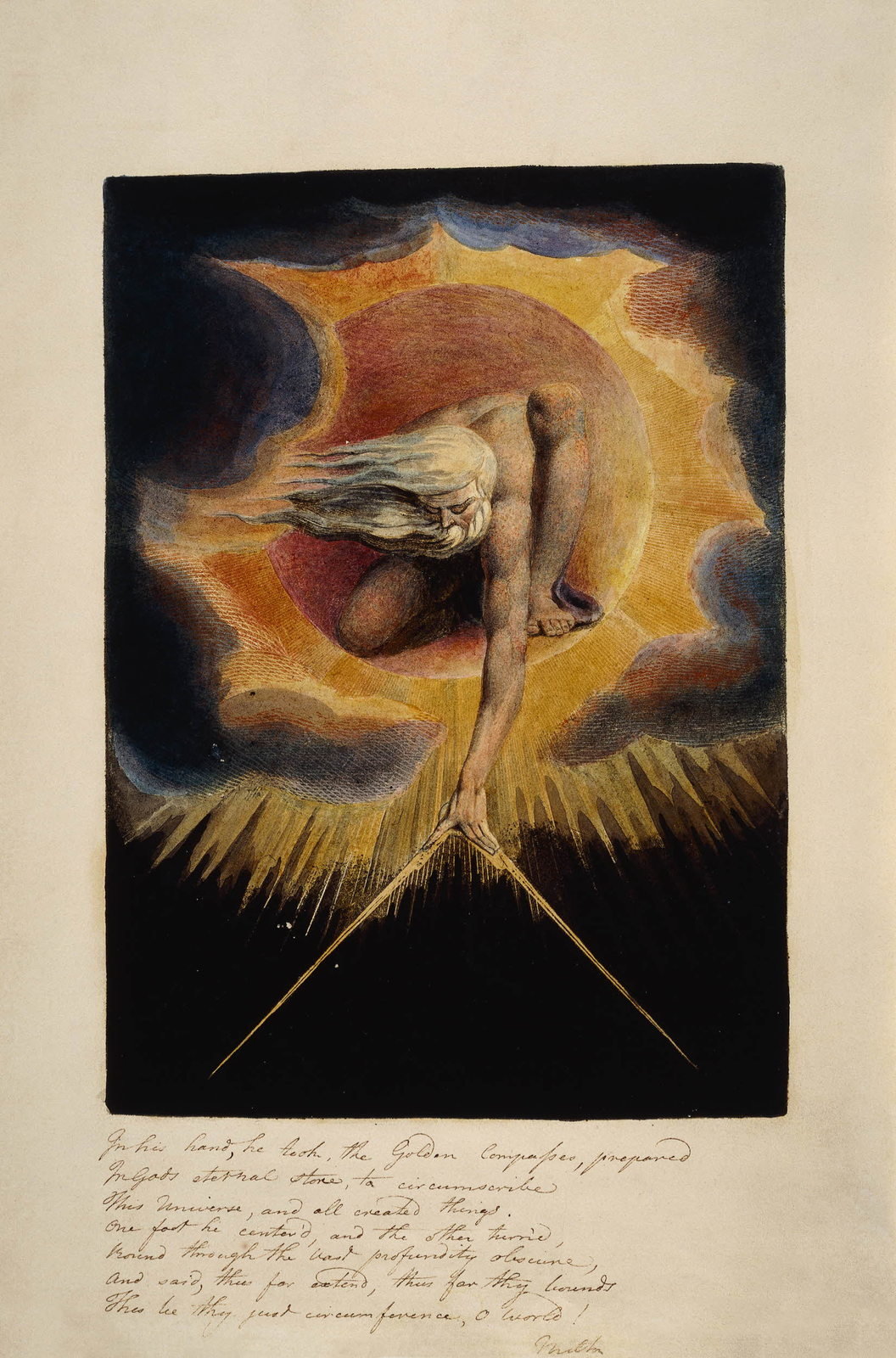 A bearded male figure (probably Urizen, Blake’s embodiment of reason and law) crouches in a heavenly sphere, its light partially covered by clouds. His left arm holds a pair of compasses and reaching down with them, he measures the surrounding darkness.
A bearded male figure (probably Urizen, Blake’s embodiment of reason and law) crouches in a heavenly sphere, its light partially covered by clouds. His left arm holds a pair of compasses and reaching down with them, he measures the surrounding darkness.The image above shows a man using two compasses to measure the darkness, kind of like a shadow. It depicts the time and growth of ideas during the Enlightenment period. Many new ideologies were born and it was a very controversial time. In late 18th century England, the mystical visions of William Blake were a powerful counterpoint to Enlightenment rationalism. Blake sought to regenerate mankind spiritually and his artistic style is unique. The Ancient of Days is the frontispiece to Blake’s mythological narrative book Europe: A Prophecy, 1794 (europeana.eu). Many new political ideas were adopted, and the thought that the higher power, God, controlling everything that occurred was dying off. People during this time began a new progressive way of thinking, it was an age of new ideas and growth for the world, and it was on large part of scientists, philosophers, and influential people like Locke, Newton, Galileo, and many others.
The Enlightenment was period of growth, development, and reason in Europe, and across the world.
This new age of ideas caught on and made people into skeptics and believers. The ideologies of the many influential people like Sir Isaac Newton (discovered gravity) and John Locke, proving were very controversial, and did not get taken well. John Locke and Issac Newton spearheaded these ideas and got them rolling, it is the other men and women of these worlds that helped carry out these ideas and bring them to the surface. This was a new age of politics, a new age of religious beliefs, and opened the eyes of the world to scientific facts and ideas. This was a time of mass expansion, and new ideas. The Enlightenment provided a controversial time in world history, many nations were being slammed with new ideas, and new ways of being ruled by the government.
The Enlightenment provided groundbreaking evidence for science and beliefs of how the world works. Sir Isaac Newton proved that there was gravity, and many philosophers began to believe that the world is not flat. Scientists and Philosophers, Galileo, Newton, and others spearheaded the idea that many naturally occurring things in the world were not because of a higher power. Galileo proved that the world was not flat, and that we were orbiting around the sun. According to the textbook A History of Western Society, the Twelfth Edition, Galileo used a telescope and sketches of the moon to prove that the Earth was not flat. It was clear from the evidence because each night the moon looked different (Page 512) . His sketches had six phases of the moon, these ideas were so controversial that he was eventually imprisoned for his ground breaking ideas. It was a time of growth and change, and not too many people agreed with what these men believed.
This period provided a lot of growth, and adoption of new ideas. The amount of expansion, construction, and progressive thinking made this time period so influential on the future. The Enlightenment impacted not just Europe, but the entire world. The United States adopted this new age of thinking and ended up using their ideas to form their government, using checks and balances to ensure that the power was not just held by one Unitarian leader. The artwork, and architecture is of those that is still seen and used today. Many people like the look of the building design, and furniture that it is still adopted today.. even the President of the United States has his penthouse decorated as such (Article clipping passed around in class). The time period was a massive change in the direction of thinking, and the Enlightenment was a huge change worldwide, it opened the eyes of the people in the world, and forever changed history.
Citations:
John McKay, Merry E. Wiesner-Hanks, et al. A History of Western Society, Vol. 2: Concise Version, 12th edition (Bedford/St. Martin’s, 2016)
"Art and Enlightenment.” Europeana Collections, William Blake, The British Museum,
www.europeana.eu/portal/en/exhibitions/baroque-and-enlightenment/art-and-enlightenment#ve-anchor-intro_2071-js.